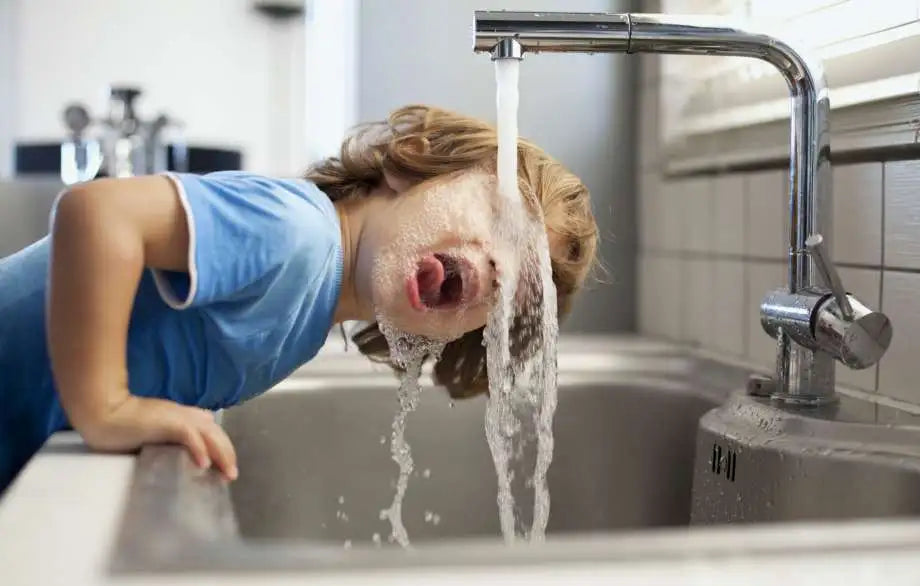Think You’re Hydrated? Think Again.
Most people assume that as long as they’re drinking enough water, they’re good to go. Eight glasses a day? Check. Reusable water bottle? Check. But here’s the thing—if your water isn’t actually hydrating you at a cellular level, you might as well be drinking air.
The problem? Tap water isn’t the hydration hero you think it is. In fact, the contaminants, lack of essential minerals, and bioaccumulation of toxins can leave your body more depleted than before. You can drink all the water in the world, but if it’s filled with the wrong stuff—or missing the right stuff—your body won’t actually absorb it the way you think.

Why Tap Water Fails at Hydration
1. It’s Packed with Chemicals That Work Against You
Municipal water is treated with chlorine and chloramine to kill bacteria, which is great if you don’t want to drink a science experiment. But the tradeoff? These chemicals disrupt your gut microbiome, dry out your skin, and may even contribute to long-term health issues like bladder cancer.
The Hidden Risk of Disinfection Byproducts (DBPs)
Even worse, chlorine isn’t just staying in your drinking water—it’s also turning into toxic disinfection byproducts (DBPs), which are linked to reproductive issues and developmental problems. Every sip you take could be exposing your body to a constant low dose of harmful chemicals, which is exactly the opposite of what real hydration should do.
💡 Bottom line: If your water still contains chlorine, it’s doing more harm than good.
2. Your Water Might Contain Heavy Metals
Lead, arsenic, and cadmium—no, this isn’t the lineup of a heavy metal concert. These contaminants are commonly found in tap water thanks to aging pipes and environmental pollution. Even in small amounts, they can wreak havoc on your nervous system, kidneys, and reproductive health. The Flint, Michigan water crisis put lead contamination in the spotlight, but millions of U.S. households are still exposed to dangerous levels of heavy metals daily.
Why This is a Big Deal
Heavy metals don’t leave your system easily. They accumulate in your tissues over time, causing long-term damage that might not show up until years later. Chronic exposure can lead to brain fog, fatigue, hormone imbalances, and even autoimmune issues.
💡 Bottom line: If your water comes from old pipes, get it tested—yesterday.
3. Microplastics: You’re Drinking Plastic (Yes, Really)
If you thought plastic pollution was only a problem for sea turtles, think again. A 2018 study found that 94% of U.S. tap water samples contained microplastics. These tiny particles hitch a ride in your drinking water, disrupt your hormones, and have even been found in human placentas.
How Microplastics Mess With Your Body
Plastics contain endocrine-disrupting chemicals (EDCs) like BPA and phthalates, which mess with your body's ability to regulate hormones. This can lead to weight gain, metabolic issues, and fertility problems—all from something as simple as drinking water.
💡 Bottom line: Your water should hydrate you, not microdose you with plastic.
🚱 Toxins Commonly Found in Tap Water & Their Health Risks
| Toxin | Source | Potential Health Effects |
|---|---|---|
| Chlorine | Added for disinfection | Disrupts gut microbiome, skin irritation, forms harmful disinfection byproducts (DBPs) |
| Chloramine | Chlorine + ammonia mix | Linked to respiratory issues, worsens asthma, damages gut lining |
| Lead | Old pipes, corrosion | Neurotoxic, lowers IQ in children, kidney damage, hypertension |
| Arsenic | Natural deposits, industrial waste | Carcinogenic, affects nervous system, skin lesions |
| Fluoride | Added to prevent cavities | Linked to thyroid issues, lowers IQ, disrupts endocrine system |
| Microplastics | Water treatment runoff, bottled water | Hormone disruption, found in blood & placentas |
| Pharmaceuticals | Runoff from wastewater | Alters hormone balance, affects liver function, antibiotic resistance |
| VOCs (Volatile Organic Compounds) | Industrial waste, pesticides | Carcinogenic, affects liver & kidneys |
| PFAS ("Forever Chemicals") | Non-stick cookware, packaging | Linked to cancer, immune suppression, hormone disruption |
| Nitrates/Nitrites | Fertilizers, sewage | Harms infants (Blue Baby Syndrome), cardiovascular issues |
| Bacteria & Viruses | Contaminated water sources | Causes gastrointestinal infections, Legionnaire’s Disease |

Final Thoughts: The Truth About Tap Water & Hydration
If you’ve been chugging tap water and wondering why you still feel parched, now you know. Hydration isn’t just about drinking more—it’s about drinking better.
Your body deserves more than contaminated, chemically treated water that does nothing but flush through your system without nourishing it. Filtering your water, remineralizing it, and restoring its natural structure will ensure that every sip actually nourishes and hydrates your body at a cellular level—not just temporarily tricking your thirst receptors.
🚰 Ready to Experience True Hydration? Let’s Talk.
Stop guessing about your water quality. If you’re ready to experience real hydration, book a free discovery call with us. We’ll walk you through the best solutions for your home, so you can stop wondering what’s in your water and start drinking water that actually fuels your health.
